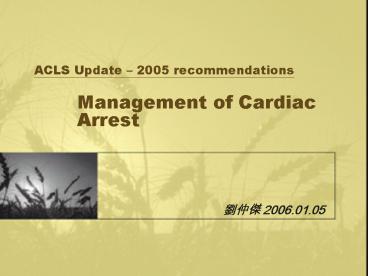ACLS Update 2005 recommendations Management of Cardiac Arrest - PowerPoint PPT Presentation
1 / 21
Title:
ACLS Update 2005 recommendations Management of Cardiac Arrest
Description:
Asystole. Survival : basic life support (BLS) and advanced cardiovascular life support (ACLS) ... Lower rates of ROSC and higher incidence of asystole ... – PowerPoint PPT presentation
Number of Views:221
Avg rating:3.0/5.0
Title: ACLS Update 2005 recommendations Management of Cardiac Arrest
1
ACLS Update 2005 recommendations
Management of Cardiac Arrest
- ??? 2006.01.05
2
Introduction
- Pulseless cardiac arrest
- ventricular fibrillation (VF),
- rapid ventricular tachycardia (VT),
- pulseless electrical activity (PEA),
- Asystole
- Survival basic life support (BLS) and advanced
cardiovascular life support (ACLS). - The foundation of ACLS
- good BLS care,
- beginning with prompt high-quality bystander CPR
- for VF/pulseless VT, attempted defibrillation
within minutes of collapse.
3
- For victims of witnessed VF arrest, prompt
bystander CPR and early defibrillation can
significantly increase the chance for survival to
hospital discharge. In comparison, typical ACLS
therapies, such as insertion of advanced airways
and pharmacologic support of the circulation,
have not been shown to increase rate of survival
to hospital discharge.
4
Access for Medications Correct Priorities
- During cardiac arrest, basic CPR and early
defibrillation are of primary importance, and
drug administration is of secondary importance. - Few drugs used in the treatment of cardiac arrest
are supported by strong evidence. After beginning
CPR and attempting defibrillation, rescuers can
establish intravenous (IV) access, consider drug
therapy, and insert an advanced airway.
5
Central Versus Peripheral Infusions
- Central line access is not needed in most
resuscitation attempts. - Peripheral IV, IO (class IIa)
- Endotracheal (liodcaine, epinephrine, atropine,
naloxone, vasopressin) lower ROSC - 2 2 ½ x dose
- Epinephrine 3 10 x dose
- Diluted to 5 10 ml
6
ACLS Pulseless Arrest Algorithm
7
Ventricular Fibrillation/ Pulseless Ventricular
Tachycardia
- Witnessed arrest 2 breaths ? defibrillator
- not witnessed 5 cycles of CPR
8
Ventricular Fibrillation/ Pulseless Ventricular
Tachycardia
- 1 shock
- Biphasic 120 200 J
- Monophasic 360 J
9
Ventricular Fibrillation/ Pulseless Ventricular
Tachycardia
- 5 cycles (2 mins of CPR) after the 1st shock then
rhythm checking
10
Ventricular Fibrillation/ Pulseless Ventricular
Tachycardia
- CPR RHYTHM CHECK CPR -- SHOCK
11
Ventricular Fibrillation/ Pulseless Ventricular
Tachycardia
- Antiarrhythmic (e.g. amiodarone) after 2 to 3
shocks
12
Ventricular Fibrillation/ Pulseless Ventricular
Tachycardia
13
Asystole and Pulseless Electrical Activity
- Identify and treat a reversible
- cause
14
Asystole and Pulseless Electrical Activity
- NOT interrupt CPR
15
Medications for Arrest Rhythms
- Epinephrine and Vasopressin
- Epinephrine 1 mg every 3 to 5 mins
- Vasopressin 40 U substituted for the first or
second dose of epinephrine - Atropine
- 1 mg IV every 3 to 5 mins if asystole persists
16
Medications for Arrest Rhythms
- Amiodarone
- 300 mg IV/IO, can be followed by one dose of 150
mg IV/IO - Lidocaine
- Lower rates of ROSC and higher incidence of
asystole - 1 to 1.5 mg/kg IV, additional 0.5 to 0.75 mg/kg
IV at 5- to 10-min interval - Magnesium
- Torsades de points (irregular/polymorphic VT
associated with prolonged QT - 1 to 2 g diluted in 10 mL D5W IV/IO push, 5 to 20
min
17
Potentially Beneficial Therapies
- Fibrinolysis
- When pulmonary embolus is suspected
18
Interventions Not Supported by Outcome Evidence
- Pacing in arrest
- Not recommended at this time
- Procainamide in VF pulseless VT
- The use is supported by retrospective study
- Norepinephrine
- Equivalent to epinephrine in the initial
resuscitation but associated with worse
neurologic outcome
19
Interventions Not Supported by Outcome Evidence
- Precordial thump
- Not recommended for BLS providers
- Class indeterminate for ACLU providers
- Electrolyte therapies
- Magnesium Torsades de points
- Routine administration of IV fluids insufficient
evidence
20
Summary
- Prevent pulseless good ACLS begins with
high-quality BLS - During resuscitation rescuers must
- provide good chest compressions (adequate rate
and depth), - allow complete recoil of the chest between
compressions, - minimize interruptions in chest compressions.
- avoid provision of excessive ventilation
- Resuscitation drugs have not been shown to
increase rate of survival to hospital discharge,
and none has the impact of early and effective
CPR and prompt defibrillation.
21
Thanks for your attention































